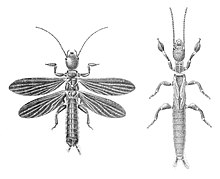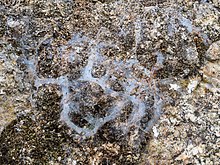紡足目
| 紡足目 化石時期:侏羅紀 – 現代
| |
|---|---|

| |
| Embia major | |
| 科學分類 | |
| 界: | 動物界 Animalia |
| 門: | 節肢動物門 Arthropoda |
| 綱: | 昆蟲綱 Insecta |
| (未分級): | 雙髁類 Dicondylia |
| 亞綱: | 有翅亞綱 Pterygota |
| 演化支: | 伴翅類 Metapterygota |
| 下綱: | 新翅下綱 Neoptera |
| 目: | 紡足目 Embioptera Lameere, 1900 |
| 異名 | |
| |
紡足目(學名:Embioptera)是分佈於熱帶及亞熱帶的一類漸變態昆蟲[1]。因該目昆蟲的前足跗節能分泌絲線,故又通稱足絲蟻、絲蟻[2]。其學名Embioptera源於希臘文ἔμβιος(活的),和πτερὀν(翅),或謂其能快速前後翻飛的翅膀。紡足目估算有1500多種[1],截至2022年只描述了400餘現生種,分為13科88屬[3];化石已發表9科14屬16種[2]。
足絲蟻成群生活,以苔蘚、地衣等有機碎屑為食,牠們能用其絲腺分泌非常細的絲,在樹皮、石牆上構築成通道(稱為絲廊)並居住於其中。
形態[編輯]
所有紡足目的形態都非常相似,儘管它們的顏色和體型確實有所不同[4]。尤其是雌性成蟲,即使在科級階元也難以在分類學上加以區分[5]。
紡足目頭部通常呈橢圓形,沒有單眼,只有複眼[2]。雄性複眼通常較小,但是一些夜間出沒及軀體部分褪色的種群,其雄性複眼則較膨大;雌性及若蟲的複眼則非常小[6]。 觸角呈線狀,有11-32節不等的鞭節;部分種群的觸角末尾會有褪色[6];雄性觸角上會有剛毛[3]。口器為咀嚼式,雌性成蟲與若蟲的顎通常較為粗壯且左右不對稱;雄性成蟲的顎形態更多樣化,在交配時會通過顎抓住雌性[3]。
紡足目有9節較為修長的腹節,約與頭部加胸部等長;腹節背部有10塊背板,腹面則有9塊腹板;第十塊背板在不同科具有不同的形態,有的完全縱向分裂,有的近乎完全分裂,有的幾乎不分裂[2]。
生活史[編輯]

紡足目大部分群居生活,沒有攻擊性[3]。雌性成蟲對卵和若蟲有撫育行為,例如將很多蟲卵縫合在絲廊中;或將部分卵埋在咀嚼樹皮形成的凹槽中;有些還會將卵守護在身邊防止寄生昆蟲寄生[7][2]。大多數種類的雌性成蟲在保護自己的卵時會表現出極強的領土意識和攻擊性,當捕食者靠近時會發出多種不同的振動信號,嚇退捕食者[8]。當卵孵化後,紡足目的雌性成蟲會分泌大量的絲保護若蟲[2]。
通常有翅的雄性成蟲壽命較短,在最後兩個齡期即不再進食[6];深色類群的雄性成蟲會在白天擴散,淺色的則一般會在夜晚擴散,找到雌性成蟲交配後即死亡[2]。
分類[編輯]
紡足目包括以下的科:
- Alexarasniidae
- Andesembiidae
- 美絲蟻科 Anisembiidae ,異絲蟻科
- Archembiidae
- Australembiidae
- Brachyphyllophagidae
- 正尾絲蟻科 Clothodidae
- 絲蟻科 Embiidae
- Acrosembia Ross, 2006
- Amazonembia Ross, 2001
- Apterembia Ross, 1957
- Arabembia Ross, 1981
- Berlandembia Davis, 1940
- Cleomia Stefani, 1953
- Diastolembia
- Diastolembia thailandensis Poolprasert, Tanruen, Senarat & Edgerly, 2021[9]
- Dihybocercus Enderlein, 1912
- Dinembia Davis, 1939
- Donaconethis Enderlein, 1909
- Electroembia Ross, 1956
- Embia Latreille, 1829
- Enveja Navás, 1915
- Galloembia Falières, Engel & Nel, 2021
- Leptembia Krauss, 1911
- Machadoembia Ross, 1952
- Metembia Davis, 1939
- Odontembia Davis, 1939
- Oedembia Ross, 2007
- Parachirembia Davis, 1940
- Parembia Davis, 1939
- Parthenembia Ross, 1960
- Pseudembia Davis, 1939
- Embonychidae
- 異尾絲蟻科 Notoligotomidae ,異小絲蟻科
- 小絲蟻科 Oligembiidae
- 等尾絲蟻科 Oligotomidae
- Paedembiidae
- Ptilocerembiidae
- Rasnalexiidae
- Sinembiidae
- 半脈絲蟻科 Teratembiidae
- 目和科的地位未定的屬:
- Clothonopsis Hong & Wang, 1987
- Condylopalma Sundevall, 1847
- Dilobocerca Ross, 1944
- Dityle Friederichs, 1908
- Drepanembia Ross, 1984
- Tillyardembia Zalessky, 1937
參考文獻[編輯]
- ^ 1.0 1.1 The Insects of Australia : a textbook for students and research workers 2nd. Ithaca, N.Y.: Cornell University Press. : 405-409. ISBN 9780801426698.
- ^ 2.0 2.1 2.2 2.3 2.4 2.5 2.6 賴澤豪; 楊強,師超凡,任東. 纺足目昆虫研究进展. 環境昆蟲學報. 2022, (3): 617–625 [2022-12-01]. (原始內容存檔於2022-12-01).
- ^ 3.0 3.1 3.2 3.3 Edgerly, Janice S. Biodiversity of Embiodea. Insect Biodiversity. 2018-05-23: 219–244. doi:10.1002/9781118945582.ch9.
- ^ Edgerly, Janice S.; Davilla, J. A.; Schoenfeld, N. Silk spinning behaviour and domicile construction in webspinners. Journal of Insect Behavior. 2002, 15 (2): 219–242. S2CID 21673429. doi:10.1023/A:1015437001089.
- ^ Edgerly, Janice S; Sandel, Brody; Regoli, Isabel; Okolo, Onyekachi. Silk Spinning Behavior Varies from Species-Specific to Individualistic in Embioptera: Do Environmental Correlates Account for this Diversity?. Insect Systematics and Diversity. 2020-03-01, 4 (2): 2. doi:10.1093/isd/ixaa007.
- ^ 6.0 6.1 6.2 Ross, Edward S. Contributions to the biosystematics of the insect order Embiidina. Part 1. Origin, relationships and integumental anatomy of the insect order Embiidina. Occasional Papers of the California Academy of Sciences. 2000, 149: 1–53.
- ^ Miller, Kelly B.; Edgerly, Janice S. Systematics and natural history of the Australian genus Metoligotoma Davis (Embioptera:Australembiidae). Invertebrate Systematics. 2008, 22 (3): 329. doi:10.1071/IS07018.
- ^ Dejan, KA; Fresquez, JM; Meyer, AM; Edgerly, JS. Maternal territoriality achieved through shaking and lunging: an investigation of patterns in associated behaviors and substrate vibrations in a colonial embiopteran, Antipaluria urichi.. Journal of insect science (Online). 2013, 13: 82. PMID 24224696. doi:10.1673/031.013.8201.
- ^ Pisit Poolprasert, Keerati Tanruen, Sinlaprachai Senarat and Janice S. Edgerly. 2021. Diastolembia thailandensis, A Remarkable New Genus and Species of Embiids (Embioptera: Embiidae) from Thailand. Journal of Hunan University Natural Sciences. 48 (10). http://JoNUNS.com/index.php/journal/article/view/768
